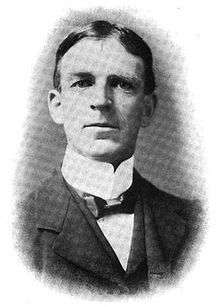William Wallace Campbell

William Wallace Campbell (April 11, 1862 – June 14, 1938) was an American astronomer, and director of Lick Observatory from 1900 to 1930. He specialized in spectroscopy.[1][2][3]
Biography
He was born on a farm in Hancock County, Ohio, the son of Robert Wilson and Harriet Welsh Campbell. After a few years of local schooling he entered in 1882 the University of Michigan to study civil engineering, graduating Bachelor of Science in 1886. Whilst at university he developed his interest in astronomy when he read Simon Newcomb's Popular Astronomy.[4]
After graduating he was appointed Professor of Mathematics at the University of Colorado but soon moved back to Michigan as an instructor in astronomy. In 1891 he was invited to work on spectroscopy at Lick Observatory in California. Campbell was a pioneer of astronomical spectroscopy and catalogued the radial velocities of stars. In 1893 he discovered the Wolf–Rayet star HD 184738 (also known as Campbell's hydrogen envelope star).[5][6] He was made a director of Lick Observatory from 1901 to 1930. His first 1919 observations were wrong, so he repeated them in 1922. He thus led a team to Australia in 1922 where he photographed a solar eclipse. The data obtained provided further evidence supporting Albert Einstein's theory of relativity, three years later than Eddington. In 1931 he accepted the role of president of the National Academy of Sciences in Washington (1931–1935).
He served as 10th President of the University of California from 1923 to 1930. He also served on the board of trustees for Science Service, now known as Society for Science & the Public, from 1923 to 1926. He served three terms as president of the Astronomical Society of the Pacific (in 1895, 1909 and 1918).
He committed suicide in California at the age of 76 by leaping to his death from a fourth-story window in San Francisco.[7][8] He was mostly blind and suffering from bouts of aphasia. This was not only very frustrating to him, but he felt that it left him a burden to his family in terms of care and expense, according to notes he left behind at the time of his death. He had married Elizabeth Ballard Thompson in 1892; they had three sons (one of them being WWI ace Douglas Campbell).
Honors and awards
- Lalande Medal of the French Academy of Sciences (1903)
- Henry Draper Medal from the National Academy of Sciences (1906)[9]
- Gold Medal of the Royal Astronomical Society (1906)[10]
- Janssen Medal (1910)
- Bruce Medal (1915)[11]
- Foreign Member of the Royal Society of London[12] (1918)
- Honorary Fellow of the Royal Society of Edinburgh (1920)[13]
- Crater Campbell on the Moon[14]
- Crater on Mars[15]
- Asteroid 2751 Campbell
- Campbell Hall on the University of California, Berkeley campus
Crocker expeditions led by Campbell
Charles Frederick Crocker and William Henry Crocker financed numerous Lick-Crocker solar eclipse expeditions. Campbell led several of these expeditions.[16]
- Solar eclipse of January 22, 1898, Jeur, Maharashtra, India
- Solar eclipse of May 28, 1900, Thomaston, Georgia
- Solar eclipse of August 30, 1905, Alhama, Spain
- Solar eclipse of January 3, 1908, Flint Island, Kiribati
- Solar eclipse of August 21, 1914, Brovary, Ukraine
- Solar eclipse of June 8, 1918, Goldendale, Washington
- Solar eclipse of September 21, 1922, Wallal, Australia
References
- ↑ Aitken, R. G. (1938). "William Wallace Campbell, 1862-1938". Publications of the Astronomical Society of the Pacific. 50: 204. Bibcode:1938PASP...50..204A. doi:10.1086/124927.
- ↑ Moore, J. H. (1939). "William Wallace Campbell, 1862-1938". The Astrophysical Journal. 89: 143. Bibcode:1939ApJ....89..143M. doi:10.1086/144035.
- ↑ MNRAS 99 (1939) 317 Obituary
- ↑ Hockey, Thomas (2009). The Biographical Encyclopedia of Astronomers. Springer Publishing. ISBN 978-0-387-31022-0. Retrieved August 22, 2012.
- ↑ Campbell, W. W. (1894). "The Wolf-Rayet stars". Astronomy and Astro-Physics. 13: 448–476 (specifically p. 461). Bibcode:1894AstAp..13..448C.
- ↑ Swings, P.; Struve, O. (1940). "HD 167362, an object similar to Campbell's hydrogen envelope star". Proc Natl Acad Sci USA. 26 (7): 454–458. Bibcode:1940PNAS...26..454S. doi:10.1073/pnas.26.7.454. PMC 1078208
 . PMID 16588382.
. PMID 16588382. - ↑ NNDB
- ↑ "UC Presidents." University of California. University of California, 04/27/2007. Web. 1 Sep 2011.
- ↑ "Henry Draper Medal". National Academy of Sciences. Retrieved 19 February 2011.
- ↑ Awarding of RAS gold medal: MNRAS 66 (1906) 245
- ↑ Crawford, R. T. (1915). "Address upon the Presentation of the Bruce Gold Medal to Dr. W. W. CAMPBELL". Publications of the Astronomical Society of the Pacific. 27: 153. Bibcode:1915PASP...27..153C. doi:10.1086/122422.
- ↑ Dyson, F. W. (1939). "William Wallace Campbell. 1862-1938". Obituary Notices of Fellows of the Royal Society. 2 (7): 612–626. doi:10.1098/rsbm.1939.0021.
- ↑ https://www.royalsoced.org.uk/cms/files/fellows/biographical_index/fells_indexp1.pdf
- ↑ "Planetary Names: Crater, craters: Campbell on Moon". planetarynames.wr.usgs.gov. IAU. 2010-10-18.
- ↑ "Planetary Names: Crater, craters: Campbell on Mars". planetarynames.wr.usgs.gov. IAU. 2010-11-17.
- ↑ "List of solar eclipse expeditions". The Adolfo Stahl Lectures in astronomy, delivered in San Francisco, 1916-1917 and 1917-1918. Astronomical Society of the Pacific. 1919. p. 65.
External links
- Bruce Medal page
- National Academy of Sciences Biographical Memoir
- Portraits of William Wallace Campbell from the Lick Observatory Records Digital Archive, UC Santa Cruz Library's Digital Collections
| Academic offices | ||
|---|---|---|
| Preceded by David Prescott Barrows |
President of the University of California 1923–1930 |
Succeeded by Robert Gordon Sproul |